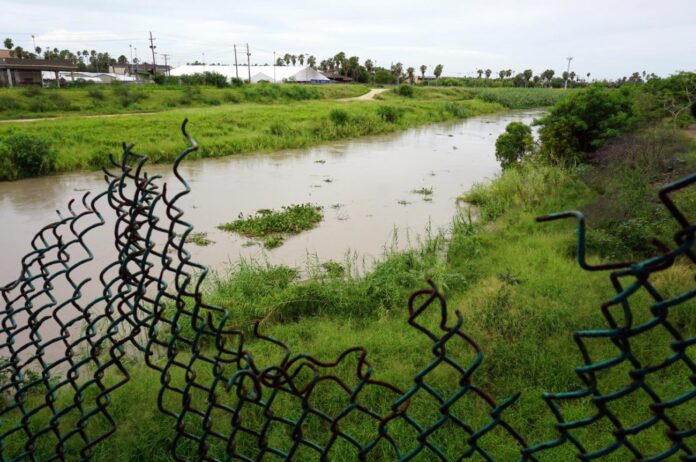
Volunteer engineers working in collaboration with Resource Center Matamoros, Global Response Management, and the Dignity Village collective are monitoring the rising level of the Rio Grande in Brownsville.
Projections show the river cresting on Thursday evening, and is anticipated to force the evacuation of the less than 1,000 asylums seekers awaiting hearings under the ‘Remain in Mexico’ program as the levee begins to flood on Mexico’s side.
On Wednesday at 2:15 p.m., engineers said the level of the river had risen to 19.37 feet at a downstream river gauge, prompting the camp past Puente Internacional to enter the “warning” phase of its evacuation plan. Should that gauge reach 21 feet, all camp residents will be evacuated into the plaza at the bridge.
Aid workers have been unable to convince many families to relocate to local shelters, a church run by pastor Abraham Barberi, and a piece of property owned by Sister Norma Pimentel, executive director of Catholic Charities of the Rio Grande Valley which have been offered as alternatives to government-run shelters.
Migrants living in the camp are already distrustful of government entities, and particularly shelters, where those coming from the camp will have less autonomy. Migrants in the past have described feeling pressured by staff and officials to give up their asylum cases and go home.
When expulsions began under the March 20 Centers for Disease Control and Prevention order that shut down nonessential travel along the U.S.-Mexico border, buses parked next to the camp left daily to Mexico’s southern border. Camp residents were offered free rides, according to aid workers in the camp, and some felt pressure to return home.
On Monday, buses arrived to transport families, but most residents refused to leave the camp until the river was visibly reaching its banks.
Organizers were given verbal confirmation that asylum seekers would be allowed to return to the camp when flood waters recede, but on Tuesday were still working to obtain that permission in writing so as to fast-track the evacuation process by instilling trust in the migrant population.

Organizers say the camp is one of the last remaining along the U.S./Mexico border. Migrants returned to Mexico have faced months-long postponements in immigration hearings held underneath tents and in trailers across the river in Brownsville.
Many of those returned to Mexico live in tents along the river for the duration of proceedings. Some have been living homeless for over a year, surviving with the assistance of Brownsville and Matamoros-based aid groups. Hearings are currently postponed until Texas reaches Stage 3 of its reopening plan. Due to a surge in cases, it will likely be months until proceedings begin again.
Prior to COVID-19, the camp’s population was estimated to be over 2,500 with more asylum seekers living further into Matamoros. A recent census conducted by Angry Tias and Abuelas of the Rio Grande Valley documented 960 residents, suggesting that people have been abandoning their cases.
The evacuation process has been tricky. Tensions flared in the camp on Monday after aid workers received warning that the camp, located on a dirt levee intended to protect Matamoros, would likely flood. The river’s level was at 15.4 feet on Tuesday afternoon, according to the National Weather Service in Brownsville.
Organizers with RCM received a call from Sister Norma, who was informed by officials with Mexico’s National Institute of Migration (INM) that water would be released from a dam upriver.
The information given by the agency was urgent and organizers were under pressure to clear the levee before 6 p.m., causing them to put in place an emergency plan developed prior to hurricane season to evacuate camp residents to the plaza next to the bridge, then to shelters across the city.
The levee did not flood. Organizers later received a call that water would be released at 7 p.m. and midnight, instead. The river rose overnight, but Cameron County officials reported no warnings about dams being released up river.
Camp residents took to social media documenting port a potties being moved out of the camp, blaming the Resource Center, which later confirmed that the company which owns the port a potties forced staff to move them off the levee in anticipation of the flood.
Some of the camp’s infrastructure is being moved to new shelter locations temporarily, the center’s director Gaby Zavala reported. She reassured both volunteers and residents that the relocation was not permanent and that the center would continue to support migrants through the duration of their asylum cases.
RCM staff and volunteers with Global Response Management are on site in Matamoros prepared to assist with evacuations if the river reaches the level outlined by engineers in their initial flood evacuation plan, which is currently set at 21 feet at a downstream river gauge operated by the International Boundaries and Water Commission.
Cameron County Emergency Management on Tuesday said they had received no alerts of dams opening, but that it could be a possibility as rain falls upriver.
According to NWS Brownsville, data from the West Gulf River Forecast Center is indicating that the river will continue to rise and is expected to crest below flood stage on late Thursday or early Friday morning.
While Matamoros and Brownsville may not flood, the flood plain along the levee is projected to flood. “There’s going to be water flowing into those areas over the next several days,” said the agency on Tuesday.
Organizers are expecting the flood warning to lift on Sunday and are working 24-hour shifts in Matamoros monitoring the river level through a USGS alert system that monitors two gauges operated by the International Boundary and Water Commission.




